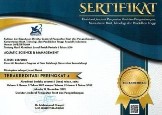The yield, nitrogen content, and dye’s binding capacity of chitin and chitosan of rotifer Brachionus rotundiformis
Abstract
Chitin and chitosan from rotifer have not been previously explored due to the problem of high biomass required for extraction. This study aimed to obtain the chitin yield from rotifer biomass produced in mass culture, and to characterize the basic properties of chitin and chitosan, especially, nitrogen content and dye binding capacity. Methods of extraction and deacetylation of chitin were adopted from Chandumpai et al. (2004) with modification. The nitrogen content was analyzed using the semi-micro Kjeldahl method (AOAC, 1984), and dye binding capacity using the method developed by Cho et al. (1998). Results show that the yield of chitin obtained from the rotifer sample was relatively small (4.64%), and the yield of chitosan was even smaller, only 2,62%. The proportion of chitosan over chitin was 52,4%. The nitrogen content of chitin and chitosan of rotifer were 4.23 to 4.36% and 7.12-7.23%, respectively. The capacity of chitin to maintain the bonded dye was relatively stronger than that of chitosan, but the chitosan had higher capacity to absorb the dye. The characterization of other important properties of chitin and chitosan to be developed as biopolymer for industry is further aspects to be assessed©
Eksplorasi kitin dan kitosan dari rotifer belum pernah dilakukan sebelumnya karena dihadapkan pada permasalahan kebutuhkan biomassa yang banyak. Penelitian ini bertujuan untuk memperoleh rendemen kitin dari biomassa rotifer hasil kultur massal, dan menjajaki karakterisasi awal sifat fisika kimia kitin yang mendasar yaitu daya ikat zat warna dan kadar nitrogen. Ekstraksi kitin dan kitosan dilakukan berdasarkan metode Chandupai et al. (2004), kadar nitrogen menggunakan metode semi-micro Kjeldahl (AOAC, 1984), dan daya ikat zar warna ditentukan menurut metode Cho et al. (1998). Dari penelitian ini, rendemen kitin yang diperoleh dari hasil ekstraksi relatif kecil berkisar 4,64 %, dan rendemen kitosan bahkan lebih kecil lagi hanya 2,62%. Proporsi kitosan dari kitin yaitu 52.4 %. Kadar nitrogen pada kitin rotifer berkisar 4,23-4,36 % dan kitosan berkisar dari 7,12-7,23%. Kitin memiliki sifat yang lebih baik dalam ketahanan untuk mengikat zat warna sebaliknya kitosan memperlihatkan sifatnya yang dapat mengikat zat warna dalam tingkat adsorpsi yang tinggi dibanding kitin. Karakterisasi sifat fisika kimia kitin dan kitosan yang penting lainnya untuk pengembangannya sebagai biopolimer dalam skala industri, merupakan aspek-aspek yang perlu dikaji lebih lanjut©
Keywords
DOI: https://doi.org/10.35800/jasm.0.0.2013.2286
Refbacks
- There are currently no refbacks.
INDEXED IN:
PUBLISHER: The JASM is published by Pascasarjana, Universitas Sam Ratulangi, Manado, in collaboration with the Indonesia of Aquatic Resources Management Association (Asosiasi Pengelola Sumber Daya Perairan Indonesia/SIPESUAR). It is printed in each publication as 'Graduate Program, UNSRAT, Manado, Indonesia – Asosiasi Pengelola Sumber Daya Perairan Indonesia'.








